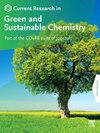Performance of activated carbon derived from tea twigs for carbon dioxide adsorption
Q2 Materials Science
Current Research in Green and Sustainable Chemistry
Pub Date : 2025-01-01
DOI:10.1016/j.crgsc.2024.100440
引用次数: 0
Abstract
Activated carbon from agro-industrial waste, namely tea twigs derived from the processing of Camellia Sinensis branches, using a potassium hydroxide activator for CO2 adsorption has been conducted in this study. Various carbonization temperatures (4000C and 5000C) and heating times of 1 h and 3 h were used in this study. The concentration of potassium hydroxide (40 % and 60 %) and the ratios of activator solutions to carbon precursor made from pyrolysis of tea twigs (2:1 and 4:1) were varied for the chemical activation process. The effectiveness results of the obtained activated carbon were characterized through using Brunauer-Emmett-Teller analyzer and Temperature Programme Desorption-CO2 to determine the surface area and capacity maximum of CO2 adsorption. The optimum condition for the synthesis of activated carbon that produces high surface area was obtained at sample CCS 400/1 A2B1 where biochar carbonized at temperature of 400 °C kept for 1 h with a ratio of activator solution and precursor 4:1 using KOH concentration of 40 %. The highest surface area was obtained 1403 m2 g−1 with pore volume 0.9 m2 g−1 and pore size 1.11 nm and proved the presence of microporous areas in produced activated carbon. The maximum CO2 adsorption capacity obtained in this study was 5.1573 mmol g−1. This result could be related to the higher amount of microporous present in the activated carbon that facilitates the access of CO2 to the active sites at the pores of activated carbon.
茶枝活性炭对二氧化碳的吸附性能研究
本研究采用氢氧化钾活化剂对农工废弃物,即茶树枝干加工所得的茶枝进行活性炭吸附。本研究采用了不同的碳化温度(4000C和5000C),加热时间分别为1 h和3 h。在化学活化过程中,改变了氢氧化钾浓度(40%和60%)和活化剂溶液与茶枝热解碳前体的比例(2:1和4:1)。通过brunauer - emmet - teller分析仪和温度程序解吸-CO2对所得活性炭的有效性结果进行了表征,确定了CO2的最大吸附表面积和容量。在样品CCS 400/1 A2B1条件下,以活化剂溶液与前驱体的比例为4:1,KOH浓度为40%,在400℃下炭化1h,获得了合成高比表面积活性炭的最佳条件。所得活性炭的最大比表面积为1403 m2 g−1,孔体积为0.9 m2 g−1,孔径为1.11 nm,证明活性炭中存在微孔区。本研究获得的最大CO2吸附量为5.1573 mmol g−1。这一结果可能与活性炭中存在较多的微孔有关,微孔有利于CO2进入活性炭孔处的活性位点。
本文章由计算机程序翻译,如有差异,请以英文原文为准。
求助全文
约1分钟内获得全文
求助全文
来源期刊

Current Research in Green and Sustainable Chemistry
Materials Science-Materials Chemistry
CiteScore
11.20
自引率
0.00%
发文量
116
审稿时长
78 days
 求助内容:
求助内容: 应助结果提醒方式:
应助结果提醒方式:


